 Ever smelled a carrot cake baking? Then imagine the scent of enormous carrot-scented clouds rising up all around you, both sweet and slightly cool, warm growing root vegetables mixed with cooler freshly tilled earth — a heavenly odor!
Ever smelled a carrot cake baking? Then imagine the scent of enormous carrot-scented clouds rising up all around you, both sweet and slightly cool, warm growing root vegetables mixed with cooler freshly tilled earth — a heavenly odor!
Riding high atop an enormous tractor at Grimmway farms outside of Bakersfield, California (the largest growers of carrots in the US), I watched thousands of freshly picked carrots rotating beneath my feet. Traveling across the country with Dr. Drew Ramsey on trains, buses and planes to research America’s favorite crunchy superfood snack — baby carrots — we also filmed giant kale fields for National Kale Day.
Tall Tales about Carrots, Myths Busted
As I walked the carrots fields, I quizzed top carrot management — including Kevin Pascoe, John Guerard, and Bob Borda — born and raised farmers, about carrot misconceptions as well as growing conditions, organic vs conventional, and life on the farm.
Don’t eat carrots because they’re high in carbs?
 FALSE. Carrots are not high in carbohydrates compared to most foods, however they do contain some along with a whole list of nutrients, including vitamin A and potassium. A 3 oz portion (about 3/4 cup) of baby carrots clocks in at 35 calories, 8 grams of carbs and 2 carbs of fiber (that means 6 grams of net carbs; as a reminder, net carbs are gram carbs minus gram fiber)
FALSE. Carrots are not high in carbohydrates compared to most foods, however they do contain some along with a whole list of nutrients, including vitamin A and potassium. A 3 oz portion (about 3/4 cup) of baby carrots clocks in at 35 calories, 8 grams of carbs and 2 carbs of fiber (that means 6 grams of net carbs; as a reminder, net carbs are gram carbs minus gram fiber)
Compare that baby carrots nutrition to your average “energy bar” that contains 22 to 15 net grams of carbs — or a slice of whole wheat bread that contains around 22 net grams of carbs. Moderate amounts of carbs are good for you and even better if you get them from a superfood source like carrots.
Baby carrots are bleached or swimming in chlorine?
FALSE. They are gently washed in chlorinated water as a food safety measure when they are peeled and cut. The chlorine (the same amount you find in drinking water) evaporates quickly after they are packed and chilled for delivery. Grimmway is the largest supplier of baby carrots, which accounts for approximately 60% of the total carrot category, and their factory facilities are a fantastic “Willy Wonka” like set up — fresh carrots doing a whirling dance, they are quickly cleaned, peeled, and shipped off swiftly to your local grocery store, within a day in most cases.
Large carrots are “whittled” down to make baby carrots?
FALSE. Baby carrots are cut from a specially raised carrot seed that produces thin, long, slender, and very sweet roots. Then they are cut into thirds and peeled (or rather buffed in a special tumbler), and bagged fresh within minutes of this process. Baby carrots are cut from the center and the very tips are packed as premium petite baby carrots.
If you can’t afford organic, should you skip veggies?
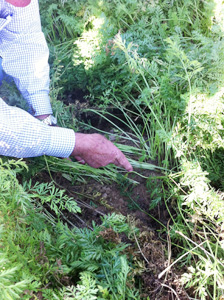 FALSE. Organic growing is better for the earth and free from commercial pesticides (not natural ones however). But if you can’t afford organic, don’t pass on carrots, go conventional!
FALSE. Organic growing is better for the earth and free from commercial pesticides (not natural ones however). But if you can’t afford organic, don’t pass on carrots, go conventional!
John Guerard, field manager with a masters degree in horticulture, explained the intricacies for farmers who make the commitment to go organic. First, fields must rest vacant for three years in preparation, along with a host of other very costly considerations to be set in place, which makes organic farming extremely costly and in some cases not feasible for farmers who are also up against changing weather patterns that threaten their livelihood. Conventionally grown carrots are typically low in pesticides, and still a healthy option for people who can’t afford organic or don’t have access to organic produce.
Conventionally raised carrots have a wonderful flavor and are one of the most inexpensive superfoods out there along with kale.
Carrots, Sweet Versatility
Carrots, in the same family as Queen Ann’s lace, come in a variety of colors from white, yellow, and orange. You’ll even find a dark purple varietal that is also called “black carrots” — rich in anthocyanins (found in the plant’s pigment) that also happen to be a powerful antioxidant.
Carrots have plenty of luscious “flavor partners” — including raisins, garlic and onions, warming spices like cinnamon, ginger, and nutmeg, along with healthy fats like nuts, seeds, grassfed meat or dairy, coconut oil, and olive oil.
Ever wonder about that sour taste some carrots can have? Terpenoids, naturally occurring compounds that can be smell faintly like paint, are more prevalent when weather patterns shift from cold to warm suddenly.
Grimmway deals with this in a unique way: they have a special resting shed — I called it the “carrot spa” — where carrots could kick back and put their feet or “roots” up for a day or so to maintain sweet flavor and block terpenoid production. This short-term storage also protects the farm from taking a huge hit when the weather doesn’t play fair, and they have to harvest early.
From Carrots to College? Higher Education On The Farm
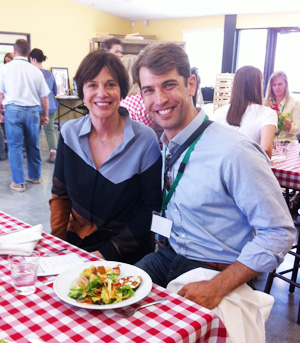 Grimmway Academy was started by Barbara Grimm, an education/food visionary who based her charter school on Alice Water’s edible schoolyard model.
Grimmway Academy was started by Barbara Grimm, an education/food visionary who based her charter school on Alice Water’s edible schoolyard model.
She has brought her vision to life — a high level of health and education for its diverse student body, and the school grounds, garden, and industrial kitchen are a sight that would bring any chef or foodie to tears!
It opened in August 2011 with grades K-3 and has added a new grade with each school year, up to grades K-6th with a maximum total of 560 students. In its gorgeous garden, students learn to plant the food they’ll eat for school lunch!
Grimmway Academy has an impressive academic program that matches what their resident chef Allison Cairns and garden manager John Vidaurreta achieve with their farm to school dining program. According to their principal Jose D. Salas, kids have longer attention spans (and better test scores) and there are a lot less absences throughout the school year. He attributes this to a very healthy diet of homegrown foods, lots of active, engaging learning, along with a lot of support from a large staff of teachers.
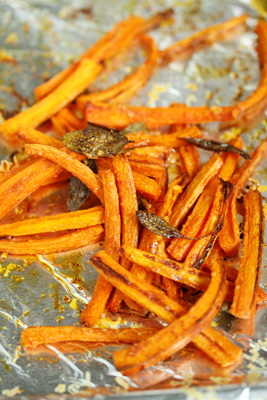 Carrot Fries
Carrot Fries
Here’s a fun super healthy way to prepare fries. Now you can feel good about giving them to your kids and feeding your own fries craving. To make them more kid friendly, omit the sage, and use mild chili powder instead of hot. For a flavor twist, add a few tablespoons of grated Parmesan and 2 cloves
Serves 4
8 large carrots (about 3/4 pound or 3/4 pound baby carrots)
4 teaspoons olive oil
8 small sage leaves (optional)
1/2 teaspoon garlic powder
1/4 teaspoon mild or hot chili powder
1/4 teaspoon salt
Preheat the oven to 425F. If using the large carrots, peel and cut into quarters. Cut each quarter into 4 matchsticks. If using baby carrots, simply cut each one in half.
Place the carrots matchsticks in a large bowl along with the olive oil, sage leaves (if using), the garlic powder, chili powder, and salt. Toss well. Transfer to a two ungreased cookie sheet and spread out. Bake 10 to 12 minutes until carrots are soft in the center and crisp on the edges.
Nutritional Stats Per Serving (Serving size: about 12 fries): 139 calories, 2 g protein, 23 g carbohydrates, 5g fat (0 g saturated), 0 mg cholesterol, 6g fiber, 313 mg sodium
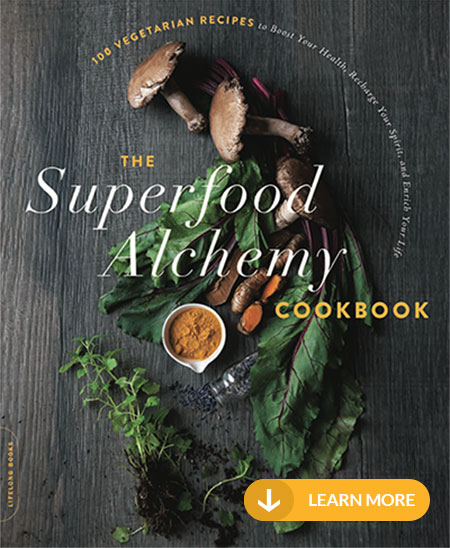

 Are you ready to look better, feel more energized, and get back that youthful feeling you remember having as a kid? I can help you on a journey that will change the way you eat — for good. My
Are you ready to look better, feel more energized, and get back that youthful feeling you remember having as a kid? I can help you on a journey that will change the way you eat — for good. My 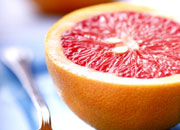











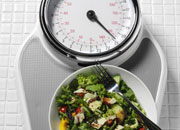


 As a healthy cooking expert, health coach and TV host,
As a healthy cooking expert, health coach and TV host, 

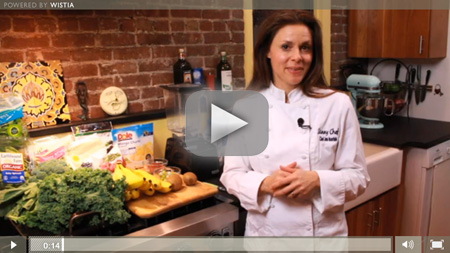
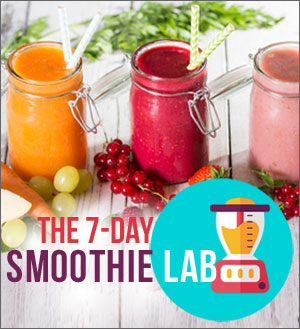
Speak Your Mind